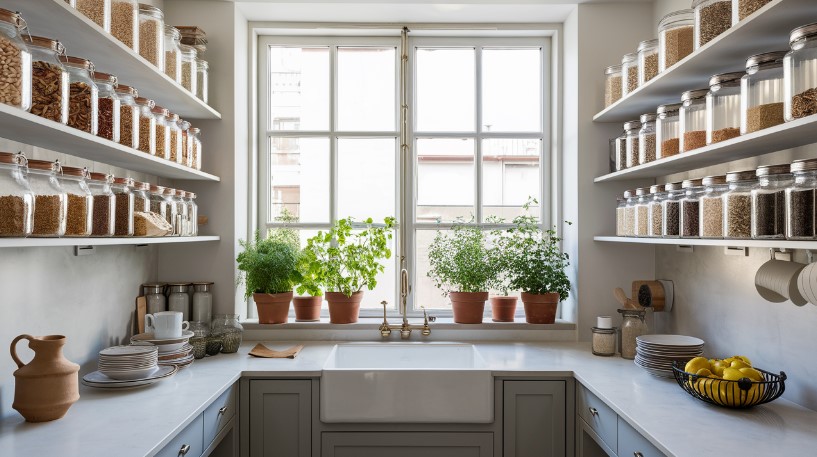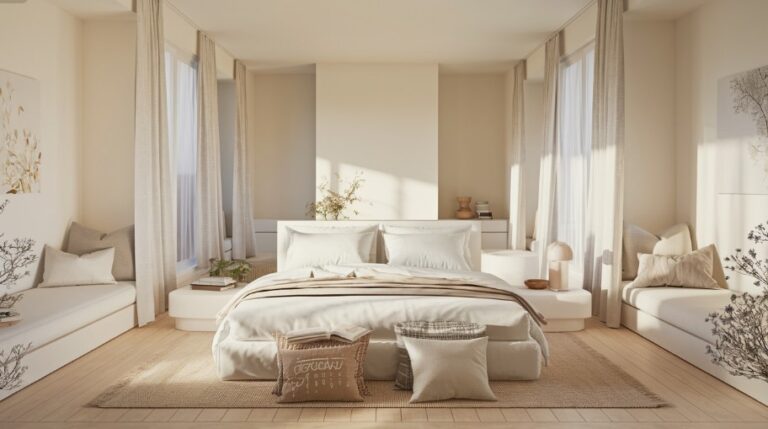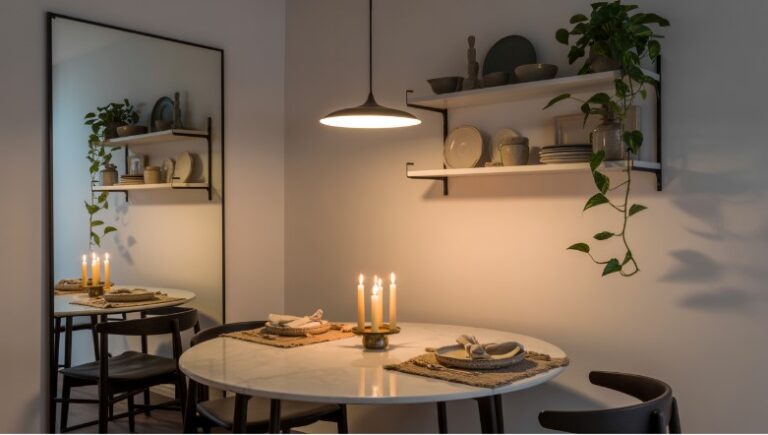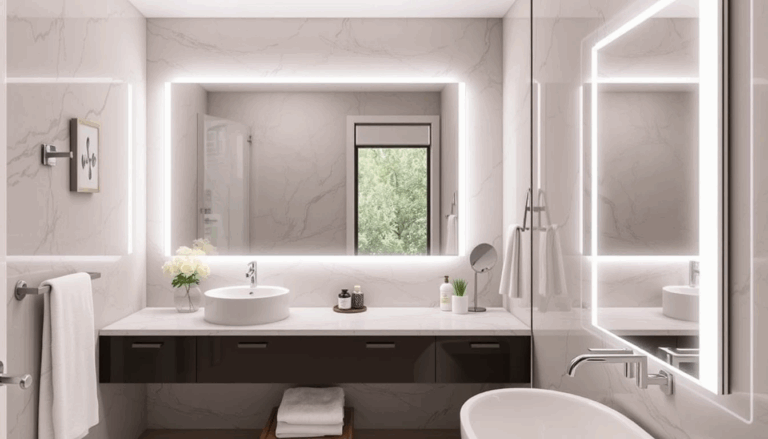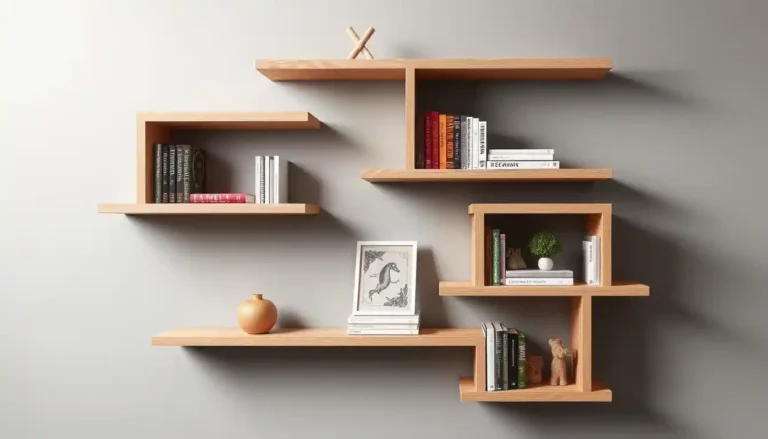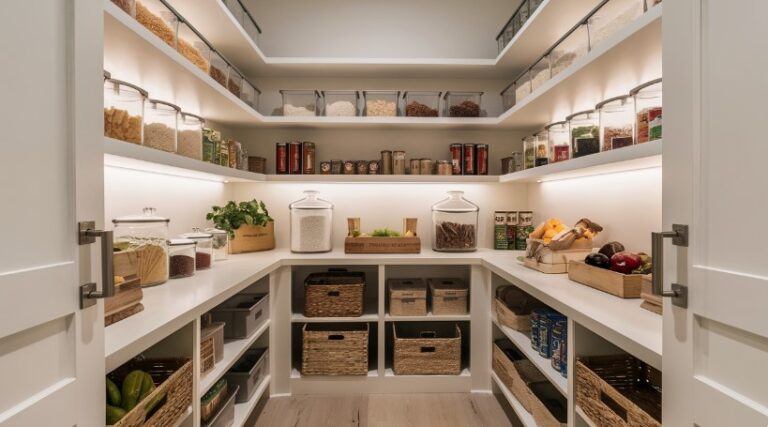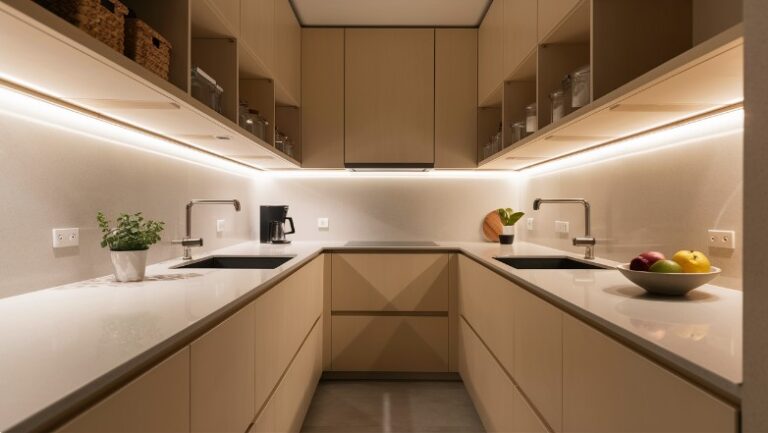7 Open Shelving Kitchen Organization Storage Ideas
Open shelving in kitchens is both trendy and practical.
It keeps your space organized and stylish. You can display and easily access dishes, glassware, and cookbooks.
These shelves save space and make your kitchen feel more open and inviting. They create a clean, clutter-free space in any kitchen.
You can personalize storage by arranging jars, baskets, or decorative items.
This guide offers creative ideas to keep your kitchen functional and beautiful. Let’s start with these smart organization tips!
1. Built-In Open Shelving
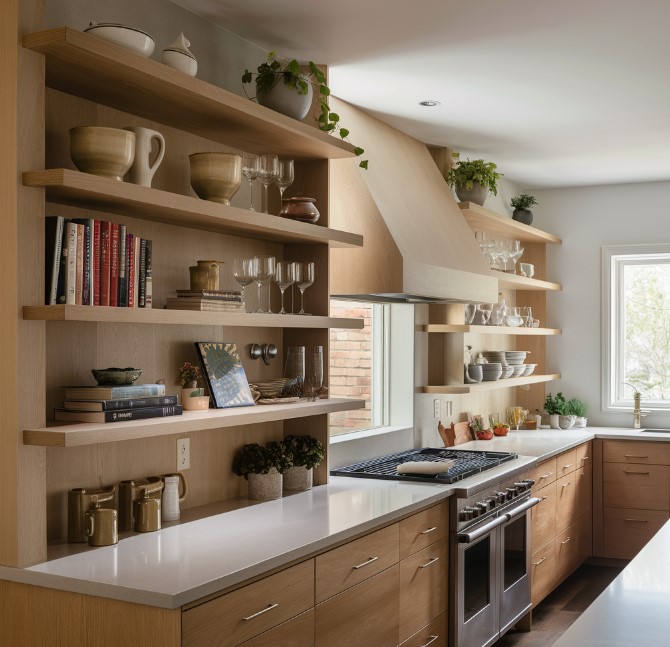
Open shelving in kitchens is both stylish and practical. It’s a perfect storage solution, custom-made to fit the kitchen’s design. This creates a unified look.
Unlike standalone shelves, built-ins integrate seamlessly. They have a sleek look that suits both modern and traditional styles.
These shelves can display ceramics, cookbooks, or plants, keeping countertops clear. This adds a personal touch and makes essentials easy to reach.
Moreover, they utilize unused wall space, boosting storage without losing style.
Built-in shelving is ideal for any kitchen, combining practicality and elegance. It’s perfect for showcasing dinnerware or enhancing design.
2. Corner Shelves
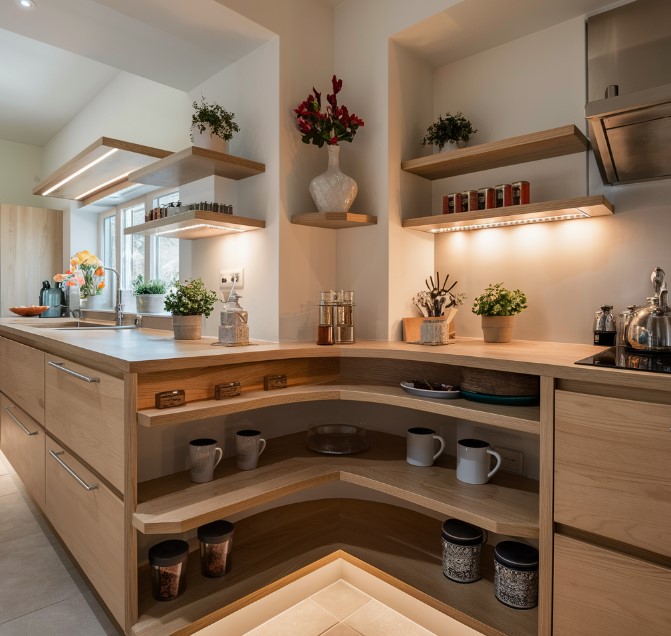
Kitchens often waste corner space, but it can be great for open shelving. Installing corner shelves can turn these awkward spots into useful and stylish storage.
Choose materials that match your kitchen’s look. Wood adds warmth, while metal gives a modern feel.
Think about what you’ll store to make the shelves functional. Keep items you use often, like mugs and spices, at eye level.
Put heavier items on lower shelves and decorative pieces, like plants, on higher ones. Balance storage and style to avoid clutter.
To link the corner shelves to the kitchen, use a matching color scheme or similar materials. For example, match the shelf finish to the countertops.
Also, use under-shelf LED lights to highlight these corners and add warmth.
3. Mixing Open and Closed Storage
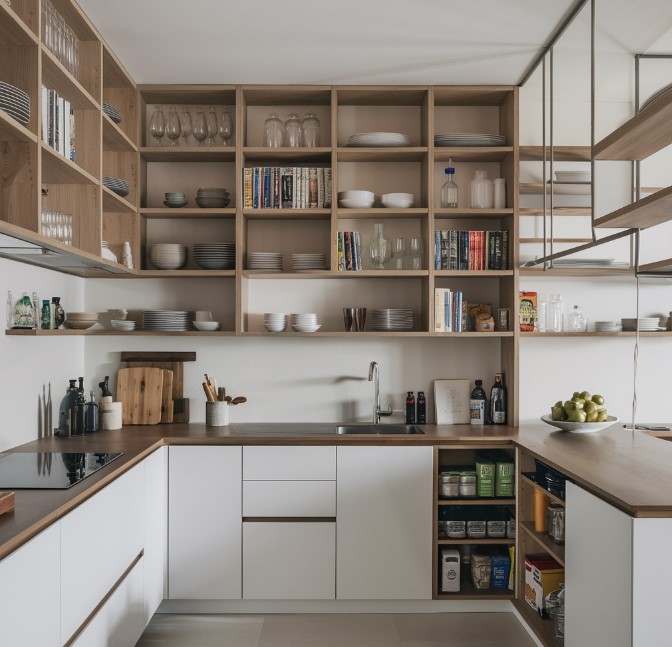
Combining open shelves with closed cabinets offers both style and practicality. Open shelves provide easy access to items and showcase dishware, cookbooks, or decor.
Closed cabinets, but, hide less attractive items like pantry goods and cleaning supplies. This mix keeps the kitchen balanced and clutter-free, merging beauty with function.
Modular designs enhance this idea. For example, place open shelves beside closed cabinets for symmetry.
Alternatively, mixing vertical and horizontal shelves adds depth and character. Pairing minimalist floating shelves with sleek shaker cabinets works well.
Open wooden shelves can provide a pleasing contrast to white cabinets. Adjustable modular systems offer customization to meet changing needs.
This mix of storage types saves space and adds interest. It makes your kitchen practical and unique.
4. Stylish Display with Decorative Items
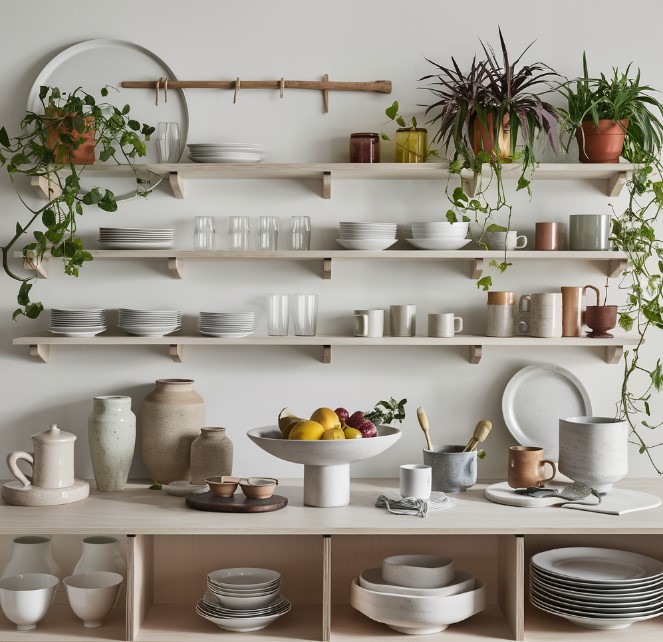
Open shelving blends function and style, turning storage into a statement piece.
Mixing decorative items with everyday essentials creates a useful, attractive display.
Start with functional items like plates, glasses, and mugs. Choose ones with matching colors or patterns for a cohesive look.
Next, add decorative elements. Small potted plants or trailing vines add greenery. They contrast nicely with neutral shelves.
Ceramic vases, artisanal jars, and hand-thrown pottery add texture. They make the space feel curated.
Larger items, like serving bowls, are important too. They can store fruit or utensils while serving as focal points.
Vary heights and shapes for visual interest, but avoid overcrowding. Negative space keeps the arrangement clean and sophisticated.
Mix practical items with decor. Your open shelves will be more than storage. They’ll be an elegant display of your personality and charm.
5. Maximizing Vertical Space
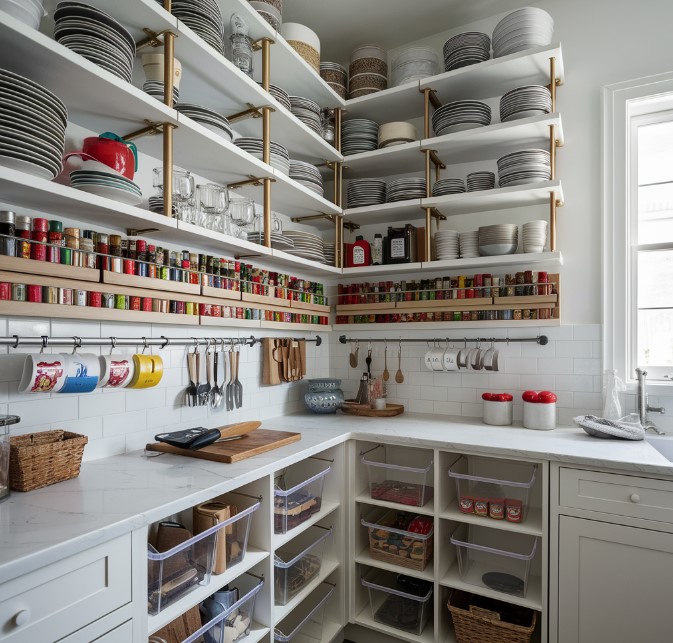
Using vertical space in open shelving kitchens boosts organization.
However, with certain methods, you can create attractive, functional storage.
First, stack items to utilize shelf height fully. Keep plates, bowls, and cups organized and within reach.
For small items like spices, tiered organizers are key. They allow for layering, ensuring nothing gets hidden. Hang mugs or utensils on hooks or rails beneath shelves for easy access.
Adjustable shelves offer customization.
Clear bins or baskets can group similar items, making the most of vertical space. These strategies will keep your kitchen organized and accessible.
6. Thematic Styling
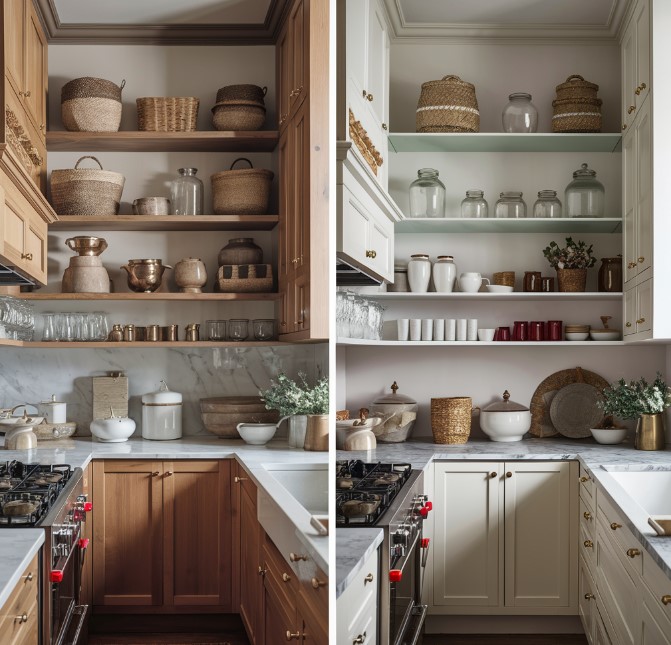
Open shelving isn’t just about storage—it’s a canvas for creativity.
Thematic styling is key to a cohesive, polished kitchen. Color and material coordination are key.
Choose a palette that complements your kitchen’s overall design. If your shelves are natural wood, pair them with earthy tones or metallic accents.
It will highlight their warmth. For white or glass shelves, opt for soft neutrals or vibrant pops of color to create contrast.
Align your shelves with your countertops and cabinets to achieve a uniform look. If your countertop is marble, use sleek-finish items.
White ceramics or glass jars will echo their elegance. Wooden countertops look great with rustic baskets or stoneware. They boost the farmhouse vibe.
Group similar-colored items together and vary heights for visual interest. Layer textures—like woven baskets, glossy jars, and matte dishes—to add depth.
A well-styled shelf blends practicality with personality. It makes your open shelving both useful and beautiful!
7. Utilizing Standalone Shelves
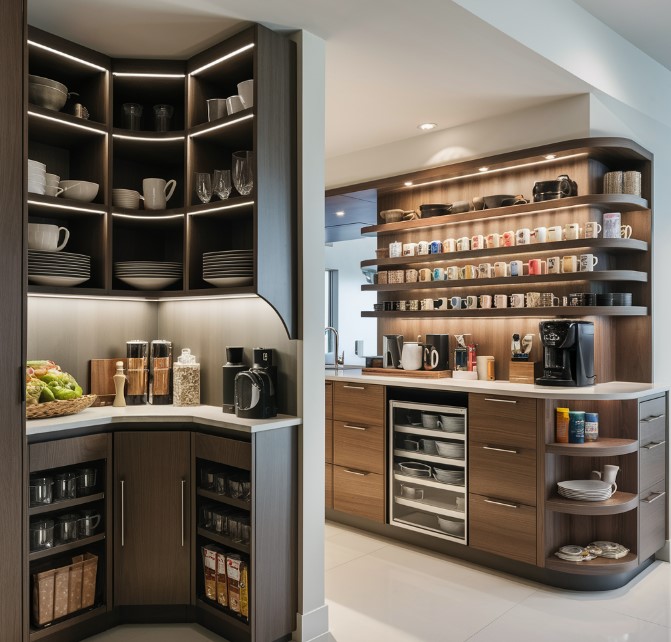
Standalone shelves revolutionize kitchen organization. They provide flexible, extra storage without permanent installation.
They’re especially ideal for renters or anyone hesitant to commit to fixed shelving. These shelves can adapt to your needs.
Use them to store dishes, display glassware, or create a mini pantry for dry goods.
The beauty of standalone shelves lies in their versatility. For a compact kitchen, opt for slim, vertical shelving units that make use of unused corners or wall space.
In larger kitchens, broader shelves can double as decorative displays and practical storage.
Choose materials like wood or metal. They should match your kitchen’s style and be durable.
Use standalone shelves creatively. Place one near your cooking station for quick access to essentials. Or, use them as a coffee bar with arranged mugs and supplies.
These shelves can even move with you. So, they are a stylish, long-term investment in organization.
Conclusion
Open shelving is both practical and stylish. It’s a top choice for modern kitchen organization.
Use open shelves to create a functional, inviting space. It will showcase your style and keep everything you need within reach.
Open shelving turns storage into a visual feature. It shows off dishware and pantry items.
The key to success is balance. Declutter often. Group similar items.
Use bins or jars to keep a tidy look. For renters or those who love flexibility, standalone shelves are ideal. They are stylish and non-permanent.
Open shelving fits your needs. Use it for a minimalist look or to add charm to a cozy kitchen. With careful planning, it can improve your kitchen’s look and use.
Use open shelving to elevate your space. Enjoy a kitchen that’s efficient and elegant.
1. What are the best materials for open shelving in the kitchen?
Choose materials that are durable, attractive, and easy to maintain.
For open kitchen shelves:
Wood brings warmth and flexibility. Hardwoods like oak and walnut are tough. Treated pine is a cheaper option.
Metal shelves, made from stainless steel or iron, have a modern look. They are very durable, which is perfect for industrial or modern kitchens.
Glass shelves offer a light, open feel. Use tempered glass for safety, but expect regular cleaning.
Laminate is affordable and adaptable. It can imitate wood or stone but may not be as durable. Stone or marble shelves are luxurious but heavy and costly.
Choose a material that fits your kitchen’s style and needs.
2. How can I keep my open shelves looking neat and organized?
To organize open shelves, group similar items. For example, put plates, bowls, and jars together.
Use baskets or clear containers for small items. Only show essential items or matching decor.
Place taller items at the back. Keep frequently used items within easy reach. Store less-used items higher up.
Regularly declutter and dust. Pick a consistent color or material, like wood, glass, or metal.
Finally, add simple decor, like plants or cookbooks, to blend function and style.
3. What types of items should I store on open shelves in the kitchen?
On open kitchen shelves, prioritize items that are useful and attractive.
Store plates, bowls, and glasses for easy access. If they match, add pots, pans, and mixing bowls.
Display potted herbs, cookbooks, or vases for a personal touch. Use clear jars for grains, pasta, and spices to stay organized.
Keep mugs and small dishes on the top shelves for safety. Limit items and group them by function or style to avoid clutter.
Open shelves showcase your favorites and create a clean, curated look.
4. Are open shelves practical for small kitchens?
Open shelves can be great for small kitchens if used wisely. They make the space feel bigger and offer easy access to daily items, thus Keeping dishes, glasses, and spices nearby.
Choose shallow shelves to avoid clutter. Group items by color or use matching containers. However, open shelves require regular cleaning to avoid dust and grease.
Mixing open shelves with closed cabinets creates balance. Use cabinets for hiding unattractive or large items. With the right care, open shelves can be both efficient and stylish.
5. How do I prevent open shelves from looking cluttered?
To avoid clutter on open shelves, aim for balance and simplicity.
First, group similar items, like plates or bowls. Use matching containers for small items, such as spices.
Limit the number of items to prevent overcrowding. Leave some space empty. Arrange items by size, with taller ones at the back.
Mix functional and decorative pieces, like a plant or artwork. This adds personality without making it feel cluttered.
Regularly remove unnecessary items and swap things around. Lastly, stick to a consistent color palette for a harmonious look.
